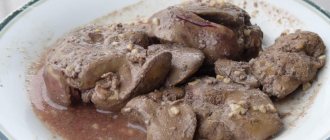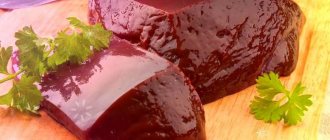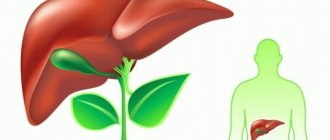When the baby turns six months old, he becomes ready to start introducing complementary foods. After the child becomes familiar with the taste of vegetables and fruits, it is time for meat dishes. Questions arise about whether offal can be used in the diet and at what age children can be given liver. Some people mistakenly think that the properties of liver are inferior, for example, to meat tenderloin. However, it contains a large amount of useful and nutritious substances, which makes it very valuable for the body of babies. Properly prepared fresh liver can provide children with their daily dose of vitamins and minerals.
Types of liver
In stores you can find different types of liver:
- beef (veal);
- pork;
- chicken;
- turkey liver;
- rabbit;
- much less often goose and duck liver.
Chicken, veal and turkey liver are best suited for baby food. They contain all the substances important for a growing body and are easily digestible. The value of chicken liver is so great that some doctors recommend its consumption by children without fail. You should avoid goose and duck liver; it is too fatty and will not benefit children’s digestion. You should give preference to a liver pate recipe made from beef liver rather than fish or poultry.
Is it possible to have chicken liver for pancreatitis and diabetes?
Patients with pancreatitis are allowed to eat chicken liver only during stable remission. During an exacerbation, this product should not be consumed due to the large amount of cholesterol. It can cause harm because it has the property of activating the pancreas and its inflammatory processes. Chicken liver will not be beneficial for pancreatitis and can cause harm to the human body.
Chicken liver has many beneficial properties for patients with pancreatitis:
- easily digestible protein;
- low fat content;
- benefits for the nervous system;
- contains heparin, which prevents thrombosis;
- has a positive effect on the heart and blood vessels;
- retinol, which has beneficial properties for vision.
However, to avoid possible harm, it is better not to abuse the offal. Patients with pancreatitis are allowed to eat chicken liver no more than once a week and in boiled form.
There will be no harm from it in this disease, but the benefits for the body will be enormous. For this disease, the offal will be especially useful due to its extensive vitamin composition. The main advantage of the liver is its high protein content, equal to its amount in white poultry meat. Vitamin A is also very important for the immunity of diabetics. Vitamin C and heparin will help prevent thrombosis.
What are the benefits of the liver?
The liver contains such important vitamins and minerals as:
- Vitamin A – strengthens vision, teeth, stimulates hair growth.
- Vitamin D (fat-soluble) - helps to absorb calcium, which forms a healthy skeleton against the backdrop of rapid growth of the baby.
- Vitamin PP, involved in the production of hormones.
- Vitamin B12 is responsible for the production of new red blood cells and the transport of oxygen in the body.
- Vitamin B9 (folic acid) – promotes the synthesis of RNA and DNA cells, the production of serotonin and dopamine, which balance the processes of excitation of the nervous system.
- Choline – improves brain activity, memory, participates in the proper formation of the central nervous system.
The liver is rich in various microelements vital for a child - iron, magnesium, zinc, copper, potassium. They are necessary for the growth and maturation of all organs and systems. In addition, the liver contains amino acids necessary for the growing body, which are not synthesized in the child’s body.
Each type of liver additionally has its own unique properties, for example:
- Beef liver improves immunity and promotes rapid recovery from infectious diseases or burns. It is easily digestible, low in calories, and increases hemoglobin.
- Pork liver has a loose structure, as a result of which it cooks quickly and tastes more tender. Contains phosphorus, sodium, vitamin H (biotin).
- Chicken liver is the richest in nutrients; it additionally contains ascorbic acid and selenium. Reduces the risk of anemia, increases the body's protective functions.
- Turkey liver is similar in taste and quality to chicken liver, and helps strengthen the immune system.
Nutritional value and calorie content of chicken liver
There is a lot of debate about the benefits and harms of chicken liver. However, no one will deny that this offal is saturated with microelements necessary for the body: protein, fats, carbohydrates, vitamins and minerals.
It includes:
- selenium - cleanses the blood well and has a positive effect on the thyroid gland;
- Vitamin C is one of the best antioxidants that effectively improves immunity;
- vitamin A has a beneficial effect on skin, hair and nails;
- vitamin E improves vision;
- iron is responsible for the level of hemoglobin growth;
- tryptophan helps get rid of insomnia.
Nutritionists note the benefits of chicken liver for the body. This is a fairly filling product, but it is low in calories.
Chicken by-product stimulates brain function: improves memory and concentrates attention. Recommended for people with mental work.
Doctors advise including liver in your diet if you are susceptible to:
- fatigue and frequent overwork;
- disorders in the immune system;
- lung diseases;
- nervous diseases;
- diabetes mellitus;
- anemia.
| Where is it contained? | Protein, g/100 g | Fats, g/100 g |
| In the liver | 20,4 | 5,4 |
| In heart | 15,8 | 10,9 |
| In chicken breast | 23,6 | 1,9 |
| In fillet | 23,1 | 1,2 |
It can be seen that chicken liver contains more protein than hearts, but is significantly inferior to meat in this regard. By-products are fattier, but they contain carbohydrates. For comparison: in white chicken meat there is only 0.4 grams, and in liver from 0.6 to 1.4 grams.
Due to the amount of protein chicken liver contains, this product:
- accelerates the absorption of nutrients;
- improves the condition of the skin;
- participates in the burning of fats and fights their deposits;
- nourishes muscles;
- satisfies hunger for a long time.
The amount of protein must be replenished daily, because it enters the body only with food. The substance is not synthesized and does not have accumulative properties, unlike carbohydrates and fats, and is especially important when losing weight while following a diet.
Due to its low calorie content (100 g contains 136 kcal), liver is considered a dietary product. For comparison: brisket contains approximately 116 kcal, red chicken contains 180.
The liver changes its calorie content depending on the processing method:
- raw - 136;
- boiled - 166;
- stewed - 164;
- fried - 210.
Naturally, the nutritional value varies depending on the oils and sauces used during the cooking process.
Chicken liver is the leader among other food products in iron content - about 17.5 milligrams of this substance per 100 grams of product. The calorie content of chicken liver per 100 grams is about 140 kcal. Chicken liver contains vitamins, and therefore its benefits for the body are enormous, including:
- folic acid, which is so necessary for women planning and expecting a child;
- ascorbic acid, which maintains energy levels and improves immunity;
- riboflavin, carotene, thiamine and niacin - these vitamins are required for the normal functioning of all body systems.
Chicken liver contains practically no fat (6 g per 100 g of product); in terms of the amount of protein (20.5 g), it is not inferior to chicken breast. It is for this reason, and also because of its rather low calorie content (140 kcal), that it is classified as a dietary product.
100 g of chicken liver contains:
- Vitamin A, 1330% (of the average daily value);
- Vitamin B1, 33%;
- Vitamin B2, 116%;
- Vitamin B4, 39%;
- Vitamin B6, 45%;
- Vitamin B9, 60%;
- Vitamin B12, 550%;
- Vitamin C 27.5%;
- Vitamin B3, 67%.
- Potassium, 11.6%
- Magnesium, 6%
- Sodium, 7%
- Sulfur, 20.4%
- Phosphorus, 33.5%
- Iron, 97.2%;
- Cobalt, 150%;
- Manganese, 15.9%;
- Copper, 38.6%;
- Molybdenum, 82.9%;
- Selenium, 99.3%;
- Chrome, 18%;
- Zinc, 55%.
In addition to such a rich vitamin and mineral composition, chicken liver contains many monounsaturated and polyunsaturated fatty acids.
It is impossible not to say about the cholesterol content in the product in question. Its amount: 350 mg per 100 g of liver. This is slightly more than the daily norm.
Chicken liver is a very healthy and satisfying product, accessible to everyone, but, unfortunately, not yet fully appreciated by everyone. Try eating it at least once a month, and believe me, this is enough to provide your body with nutrients that are not inferior in composition to special vitamin complexes sold in pharmacies.
- folic acid, which is so necessary for women planning and expecting a child;
- ascorbic acid, which maintains energy levels and improves immunity;
- riboflavin, carotene, thiamine and niacin - these vitamins are required for the normal functioning of all body systems.
- cobalt;
- molybdenum;
- chromium;
- copper;
- phosphorus;
- potassium;
- sodium;
- magnesium;
- calcium.
| Product type | Calorie content | Squirrels | Fats | Carbohydrates |
| Stewed | 142 kcal | 18.47 g | 6.25 g | 1.58 g |
| Fried | 172 kcal | 20.49 g | 9.05 g | 2.29 g |
| Boiled | 159 kcal | 24.33 g | 6 g | 1.72 g |
Flaws
Each type of product has its own disadvantages:
- beef liver is harsh and requires preliminary cleaning of the film and the gallbladder duct;
- chicken by-products can cause allergic reactions;
- any liver must be exceptionally fresh: during long-term storage, toxins accumulate in it that are dangerous to the baby’s health;
- chicken liver is contraindicated for children with bladder diseases;
- has a specific taste that not everyone likes.
Harm to chicken liver and contraindications
- It is important to realize that the liver plays the role of a filter in the bird’s body, collecting all harmful and toxic substances. Therefore, if birds are fed chemical additives, such a product may cause harm to humans instead of benefit.
- This by-product cannot be stored for a long time. It quickly deteriorates and accumulates substances that are harmful to humans. As a result, such an offal will not retain its beneficial properties.
- We must not forget about excess cholesterol in the liver, so its consumption must be limited.
How to introduce liver into your diet
Which liver should a child try first? First, it is recommended to introduce veal liver, and only after that chicken liver.
To prepare the first puree you need:
- Clean fresh liver from veins and rinse thoroughly.
- Boil a whole piece or cook in the oven for 20 minutes, without salt. During the cooking process, you need to change the water, that is, cook half the time in one water, half in another.
- After the liver is ready, you should grind it until smooth using a blender.
- To prevent the resulting porridge from being dry, you can add broth in which the liver, breast milk or formula was cooked. The consistency should be similar to liquid mashed potatoes.
You should start trying a new dish only in a homogeneous form, in the amount of 0.5 teaspoon, increasing the portion every day until you have 70-80 grams.
When your baby gets used to the taste, you can mix the liver with broccoli or mashed potatoes. Over the age of 1 year, liver dishes for a child can be prepared in the form of small pieces, since he already knows how to chew.
When can you give your child liver?
By the age of six or seven months, most babies already begin to be given complementary foods. Of course, complementary feeding products are selected very carefully, and appropriate heat treatment is carried out. To begin with, the baby is offered fruit and vegetable purees, meat complementary foods, and then many mothers have a question: when can you give your child liver ? A lot can be said about the nutritional value of such a product, but its main advantage is that it helps strengthen the immune system, since regular consumption of liver increases the amount of hemoglobin in the blood. And this helps the body successfully fight viruses and infections.
Age when you can start giving liver to your baby
There is no consensus among experts on this matter. According to some pediatricians, a child’s body can easily absorb the product at the age of six months. Other experts are sure that you should wait until the baby’s digestive system gets stronger and gets used to more adult food. They advise introducing liver into the diet no earlier than eight months of age. There is also a group of doctors who believe that consuming liver can do more harm than good. This opinion is based on the fact that this organ is a filter in the body, and the parents who bought the liver cannot know what they fed the animal.
Rules for cooking liver
If you have already decided what kind of liver you will give to your one-year-old child: chicken, beef or rabbit, then you should know a number of rules for preparing this product.
* The first thing you need to know is that the most acceptable type of liver is veal (or beef). It is quite soft and the most hypoallergenic, which cannot be said about chicken.
* Second, boil the product before use, then rub it through a sieve several times (or turn it in a meat grinder). Not every baby likes the specific taste of liver, and therefore it is recommended to add it to vegetable purees or porridges. If you don’t have time to prepare the liver, you can buy ready-made jarred puree.
How to prepare liver puree for babies, video
© Сhildnmom.ru 2011- 2019
Breastfeeding, what are the problems?
Honey gingerbread for children
Children's sandwiches for the holiday
Related posts:
Vegetable broth
Cooking fish dishes for children
Nutrition of premature babies
How to choose the right liver
When choosing a liver for your child, you should pay attention to the following points:
- Good appearance: even color, shiny smooth surface.
- The presence of stains or plaque indicates a stale product.
- It is worth buying from trusted suppliers to be sure that the animal has not been injected with growth hormones or antibiotics. The liver is a filtering organ and is capable of accumulating negative chemicals.
- The offal should have a slight sweetish odor.
At what age can a child be given chicken, beef or pork liver?
All products contain beneficial substances for the human body. The child is not yet sufficiently familiar with the environment, so his transition to an “adult” diet must begin with caution. The child’s parents are the child’s protectors, and they are the ones who should know how the child should follow the “gastronomic path.” Adults are obliged to properly begin to introduce a child to such a useful product for the development of the body as liver. Let's figure out what type of offal can be used as food for the baby.
Cooking rules
Knowing how to prepare chicken liver for your child correctly, you can avoid his refusal due to insufficient juiciness or special taste. In order for the liver to be soft and loved by the baby, you should follow the rules:
- Rinse thoroughly under running water, cut out fat.
- Do not cook the liver for more than 20 minutes; it becomes tough from prolonged exposure to temperature.
Depending on the age of the children, you can offer them liver in the form of homogeneous soufflés or pates, casseroles, small cut pieces, and chicken liver pancakes. Recipes for several particularly popular dishes that children eat with great appetite are presented below.
Including liver dishes in a child’s diet
Pediatricians and children's nutritionists recommend using liver for complementary feeding when the child is 7-8 months old. Before this, he became familiar with the taste of meat, and the taste properties of a new product should not surprise him.
Since young parents do not thoroughly know the physiological characteristics of the newborn, day after day they must observe how the child perceives food: does he have allergic reactions to any foods, does he have any pain, what kind of stool does he have? etc.
The benefits of liver foods for complementary feeding are noted by both pediatricians and pediatric nutritionists, but young parents should remember some precautions:
- The time of the first complementary feeding for this product is not precisely defined - it varies depending on the characteristics of the individual child’s body. It’s not scary if an eight-month-old child cannot digest the liver - a little time will pass and food intake will return to normal.
- The child himself will let you know when he is full - there is no need to force him to eat the whole portion. The first attempt at complementary feeding will help determine how much food a newborn needs to be full.
- Liver is a universal product: purees, soufflés, pates, soups, pancakes, cakes and other dishes are prepared from it. You need to choose a recipe that is tailored to the child’s age. You should start with light dishes (pate, soup or soufflé).
Liver pancakes
It is preferable to cook pancakes from chicken liver. The recipe is very simple:
- 500 grams of liver;
- one onion;
- 3-4 pieces of white bread soaked in milk (or 4 tablespoons of breadcrumbs);
- 3 tablespoons sour cream;
- two eggs;
- salt to taste.
In a blender or using a meat grinder, mix the liver, onion, and bread. Add sour cream, eggs, salt to the resulting mass. Let it brew for 20 minutes. Heat a frying pan and spoon pancakes onto it, frying over high heat for 3 minutes on each side. After turning over, you can close the lid.
The pancakes are ready and can be served with sour cream.
Liver in baby food
Pork liver is also very useful for children's nutrition. Pork liver contains a lot of proteins and fats, a large amount of amino acids, vitamins, minerals and enzymes. However, nutritionists do not recommend including such a liver in the diet of children due to its high fat content. It is best to include veal or beef liver in your child’s diet. The use of such liver strengthens the immune system, maintains normal hemoglobin, and is also a means of preventing kidney and nervous system diseases. In addition, beef liver promotes the restoration of tissues, many organs and systems during injuries, burns and infections. Chicken liver is also very beneficial for children. It is an excellent remedy for fatigue, lung diseases and poor vision. Chicken liver contains a large amount of folic acid, which is necessary for young children.
Souffle
Liver soufflé is great for children. Ingredients:
- 200 grams of liver;
- one carrot;
- one onion;
- 1 tablespoon semolina;
- 30 grams of milk or mixture;
- one egg.
Grind the onion, carrots and liver using a blender, break the egg into the resulting mixture, add semolina and milk, mix. Place in a multicooker bowl and bake in baking mode for 30 minutes (or place in a mold and place in an oven preheated to 180°C).
At what age can children be given liver in the form of a soufflé? From 8-9 months, it is well baked, tender in consistency and pleasant in taste.
Beef liver pate
The pate recipe can be varied by adding various ingredients according to the child’s wishes and preferences: carrots, onions, potatoes, meat, herbs, and so on. You will need:
- 300 grams of liver;
- vegetables (carrots, onions, zucchini);
- one chicken or quail egg;
- 20 grams of butter;
- salt to taste.
Vegetables and liver are boiled until tender. After this, cut into pieces and grind in a meat grinder or blender until a homogeneous composition. Oil and salt are added to the resulting mixture. The pate is ready and can be served with a side dish (mashed potatoes) or as a sandwich, spread on bread.
Braised chicken liver
One simple way to prepare liver is to stew it with vegetables and serve it with rice. Required:
- 300 grams of liver;
- one onion;
- one carrot;
- 1 cup chicken broth.
Rinse the liver, dry with a paper towel and cut into small pieces. Grate the carrots on a fine grater, cut the onion into cubes. Place the liver in a heated frying pan with vegetable oil and fry it over medium heat for 5 minutes. Then add the vegetables and fry together for 10 minutes. Next, pour in the broth, close the lid and simmer over low heat for another 10-15 minutes.
As a side dish, boil rice, make a mound of it on a plate, put stewed chicken liver on top and pour gravy on top.
Liver dishes are tasty and healthy food for children. The liver prepared using the above methods becomes tender and loses its specific flavor. But it is still worth deciding at what age liver can be given to children, taking into account the characteristics of this product.
At what age can you give chicken liver to a child?
Attitudes towards chicken liver vary. Some adults consider it a healthy food product, while others say that eating liver is harmful. Some people cannot stand the taste of this product, but others really like it. Moreover, if chicken liver periodically appears on the dinner table in a family with a small child, the question always arises when it can be included in the baby’s diet. In addition to the recommended age for learning about liver, mothers should also learn how chicken liver is beneficial for the child’s body and how to prepare this product for the children’s menu.











